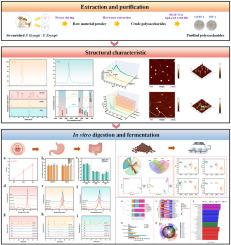Novel insights into selenium-biofortified P. eryngii polysaccharides: Unveiling selenium release patterns and gut microbiota modulation through in vitro models
IF 11
1区 农林科学
Q1 CHEMISTRY, APPLIED
引用次数: 0
Abstract
Selenium biofortification of P. eryngii was achieved through exogenous selenium supplementation during cultivation, significantly increasing its selenium content. In this study, a Se-enriched polysaccharide (SePEP-1) and a natural polysaccharide (PEP-1) were isolated from P. eryngii. Structural analysis revealed distinct differences between the two. The molecular weight of SePEP-1 (2.39 × 106 Da) was markedly higher than that of PEP-1 (1.85 × 106 Da). Although both SePEP-1 and PEP-1 were composed of glucose, galactose, and mannose, SePEP-1 exhibited a relatively lower proportion of glucose. Characterization by FT-IR, XRD, glycosidic linkage analysis, and AFM confirmed that selenium biofortification markedly altered the structural characteristics of P. eryngii polysaccharides. In vitro digestion experiments demonstrated strong resistance of both polysaccharides to gastrointestinal degradation, with minimal selenium release (<9 %) from SePEP-1. In contrast, during in vitro fermentation, SePEP-1 exhibited a strong capacity for selenium release (>85 %), accompanied by a significant increase in short-chain fatty acids (SCFAs) (p < 0.05). After 48 h of fermentation, SePEP-1 exerted remarkable prebiotic effects, significantly enriching Bacteroides and related taxa while strongly suppressing pathogenic bacteria such as Escherichia/Shigella and Salmonella. By comparison, PEP-1 selectively promoted the growth of certain Firmicutes, highlighting distinct microbial modulation patterns. Collectively, these findings demonstrate that selenium biofortification enhances the nutritional and functional properties of P. eryngii polysaccharides, providing a novel dietary strategy to improve gut health and microbial balance.

硒生物强化P. eryngii多糖的新见解:通过体外模型揭示硒释放模式和肠道微生物群调节
在培养过程中,通过添加外源硒,可以显著提高黄颡鱼的硒含量,实现黄颡鱼硒的生物强化。本研究分离了富硒多糖(sepp -1)和天然多糖(PEP-1)。结构分析显示两者之间存在明显差异。sepp -1的分子量(2.39 × 106 Da)明显高于PEP-1 (1.85 × 106 Da)。虽然SePEP-1和PEP-1都由葡萄糖、半乳糖和甘露糖组成,但SePEP-1的葡萄糖比例相对较低。通过FT-IR、XRD、糖苷连锁分析和原子力显微镜(AFM)表征证实,硒生物强化显著改变了羊角多糖的结构特征。体外消化实验表明,这两种多糖对胃肠道降解具有很强的抵抗力,SePEP-1的硒释放量最小(< 9%)。相比之下,在体外发酵过程中,SePEP-1表现出较强的硒释放能力(> 85%),同时短链脂肪酸(SCFAs)显著增加(p < 0.05)。发酵48 h后,SePEP-1发挥了显著的益生元作用,显著丰富拟杆菌及其相关类群,同时对致病菌如埃希氏菌/志贺氏菌和沙门氏菌有较强的抑制作用。相比之下,PEP-1选择性地促进某些厚壁菌门的生长,突出了不同的微生物调节模式。综上所述,这些研究结果表明,硒生物强化可提高双歧杆菌多糖的营养和功能特性,为改善肠道健康和微生物平衡提供了一种新的饮食策略。
本文章由计算机程序翻译,如有差异,请以英文原文为准。
求助全文
约1分钟内获得全文
求助全文
来源期刊

Food Hydrocolloids
工程技术-食品科技
CiteScore
19.90
自引率
14.00%
发文量
871
审稿时长
37 days
期刊介绍:
Food Hydrocolloids publishes original and innovative research focused on the characterization, functional properties, and applications of hydrocolloid materials used in food products. These hydrocolloids, defined as polysaccharides and proteins of commercial importance, are added to control aspects such as texture, stability, rheology, and sensory properties. The research's primary emphasis should be on the hydrocolloids themselves, with thorough descriptions of their source, nature, and physicochemical characteristics. Manuscripts are expected to clearly outline specific aims and objectives, include a fundamental discussion of research findings at the molecular level, and address the significance of the results. Studies on hydrocolloids in complex formulations should concentrate on their overall properties and mechanisms of action, while simple formulation development studies may not be considered for publication.
The main areas of interest are:
-Chemical and physicochemical characterisation
Thermal properties including glass transitions and conformational changes-
Rheological properties including viscosity, viscoelastic properties and gelation behaviour-
The influence on organoleptic properties-
Interfacial properties including stabilisation of dispersions, emulsions and foams-
Film forming properties with application to edible films and active packaging-
Encapsulation and controlled release of active compounds-
The influence on health including their role as dietary fibre-
Manipulation of hydrocolloid structure and functionality through chemical, biochemical and physical processes-
New hydrocolloids and hydrocolloid sources of commercial potential.
The Journal also publishes Review articles that provide an overview of the latest developments in topics of specific interest to researchers in this field of activity.
 求助内容:
求助内容: 应助结果提醒方式:
应助结果提醒方式:


